This article is part of a series of topical blogs exploring key insights from our Fintech2025+ report, which is available to download now.
As technological innovations make the world smaller and more interconnected, cross-border payments have become a crucial component of international trade and finance. Businesses now need to accept payments from various methods across different countries. And, as global commerce evolves, so do the expectations of consumers and businesses looking for the same innovative efficiencies they get from domestic payments. This global digital economy and the advancements in payments technology that support it, are pushing the cross-border payments market into a pivotal stage.
To analyze and better understand this growing demand for cross-border payment services, Convera partnered with the world’s foremost independent global advisory firm, Oxford Economics, and leading source of fintech news, the Paypers, to produce the Fintech 2025+ report.
This article breaks down the report’s findings on the current and future state of the cross-border payments market, including its size and scope, forecasts for its future, revenue generation mechanisms, and the regional leaders shaping this space. From impressive growth predictions to the transformative impact of fintech innovations we examine the factors driving this multi-trillion-dollar industry and what the future holds.
Sizing the cross-border payments market
Cross-border payments can be divided into two segments: wholesale and retail. The wholesale market, which consists of high-value transactions between commercial banks typically related to FX trading and related activities, amounted to an impressive $146 trillion in 2023.
Non-wholesale cross-border payment flows, often referred to as the retail market, totaled a much smaller but still sizable $44 trillion.
The retail cross border payments market is comprised of four key segments: Business-to-business (B2B) which forms the majority and consists of trade-related payments and international transfers by multinational corporations; consumer-to-business (C2B) which covers e-commerce and tourism related purchases; consumer-to-consumer (C2C) remittance flows, particularly those sent by migrants to their home countries; and the smallest segment, business-to-consumer (B2C) representing business disbursements to individuals, including payroll and marketplace payments.
New competition is shaking up the market as players race to take a slice out of this multi-trillion-dollar opportunity. Most new entrants are focused on low-value transactions in the C2C, B2C, and B2B segments, which are currently underserved by banks and traditional payment providers.
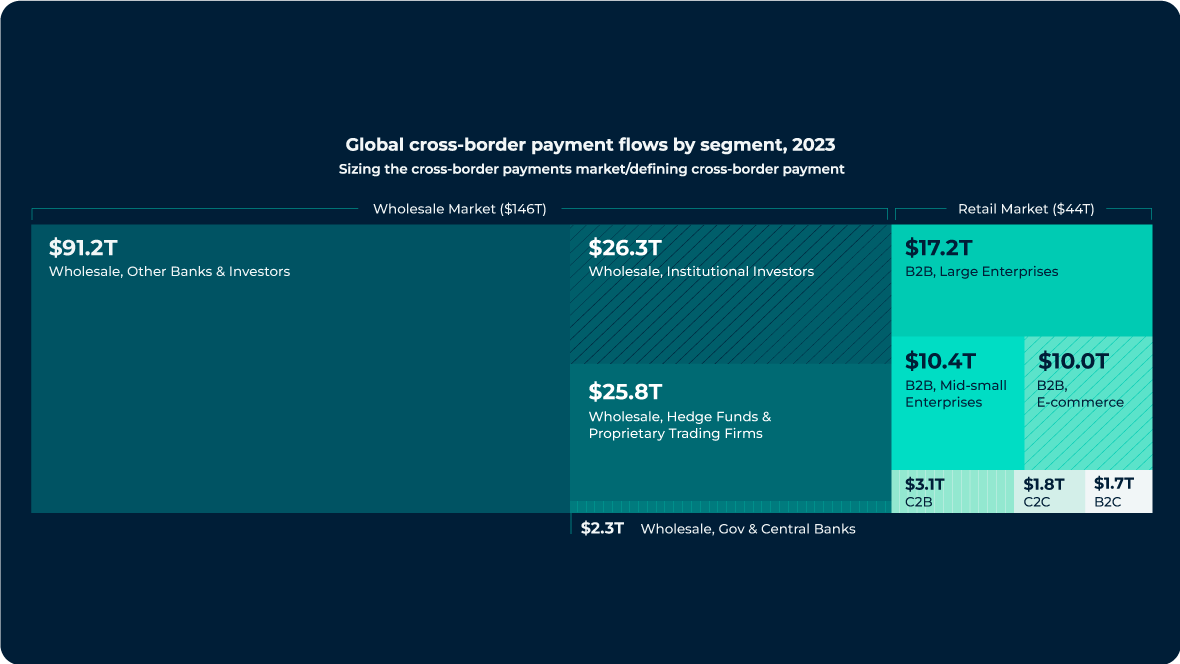
Revenue dynamics for international payments
Cross-border payment revenues are generated by the fees associated with the underlying payment flow. The associated revenue pool for cross border payments amounts to $193 billion, and is split between transaction fees and FX revenues, with estimates suggesting the average per transaction to be over $20.
However, margins vary significantly across segments. B2B transactions often involve direct bank transfers or an in-house processing which results in lower margins compared to consumer transactions that frequently involve intermediaries and value-added services. Managing multiple currencies and transaction fees in bank accounts can be particularly challenging, adding to the complexity and cost of the international payment process.
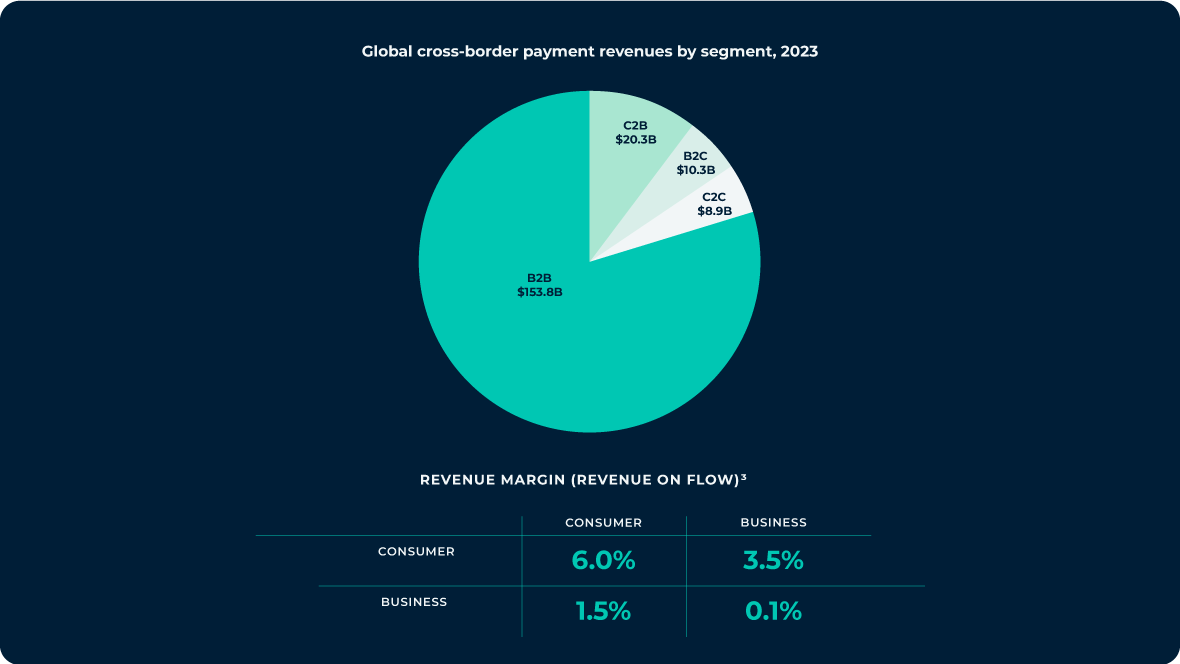
The B2B segment leads the pack by far, representing 80% of global revenues and includes both wholesale and retail payments. Banks handle most high-value payments with comparatively low margins. However, significant growth potential lies in low-value B2B transactions, which are often underserved by banks and have been slower to digitize compared to other cross border payment segments.
Estimates suggest that the pandemic has boosted the C2B segment, which accounts for 10% of cross border payment revenues, while the B2C and C2C segments trail behind.
North America leads the cross-border payments market today
When we break things down by region, North America sits on top with roughly 28% of total revenue in 2023. The region benefits from a supportive legal framework, strong technology infrastructure, and growth drivers such as widespread use of ecommerce. However, Asia-Pacific is closing the gap, achieving 26% of global revenues driven by rapid developments in infrastructure and increased digital adoption.
Europe makes up approximately 20% of global revenues, with the implementation of the Single Euro Payments Area (SEPA) across the EU supporting cross-border payments growth through lower fees and shorter clearing times. Cross-border payments have also gained momentum in Latin America (16% of global revenues), as the pandemic forced cash-dependent economies to go digital. Alternative payment methods such as digital wallets and mobile payments are becoming increasingly significant in these regions.
The Middle East and Africa account for 10% of the cross border payments market. Remittances are particularly important in the Middle East, while Africa remains constrained by a lack of digital infrastructure and safe, cost-effective options for transferring money. However, fintech innovations increasingly display the potential to deliver financial inclusion to regions like Africa.
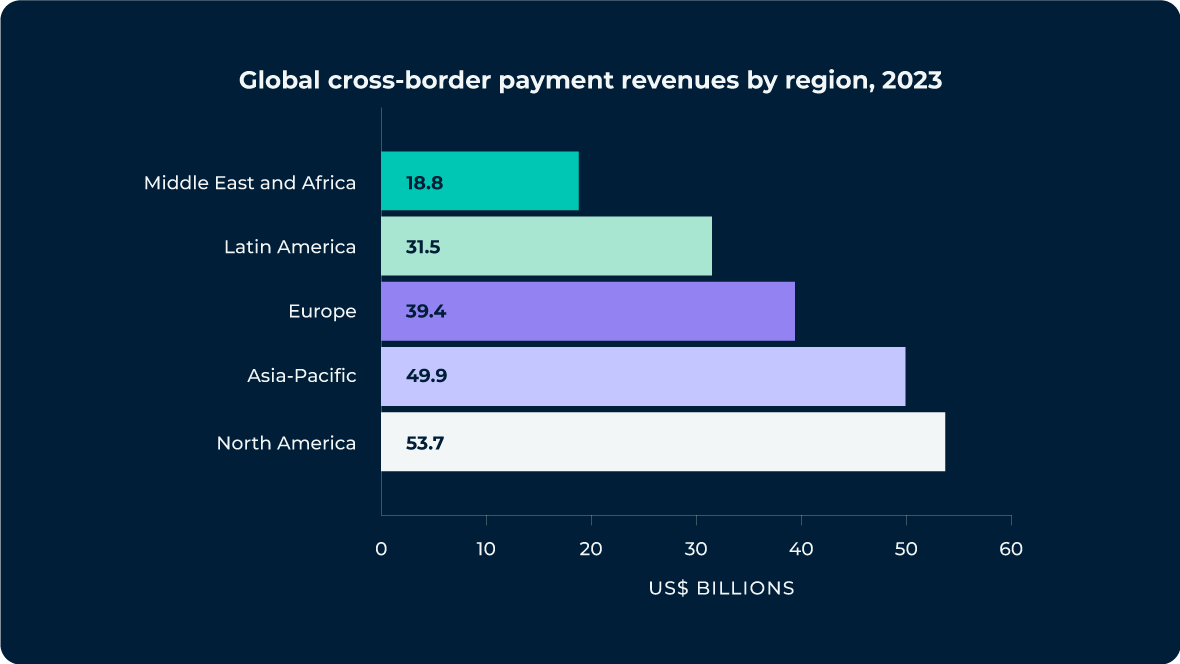
Market outlook: Cross border flows to hit $290 trillion
A key finding of the Fintech 2025+ report is the anticipated surge in cross-border payments flows, projected to reach $290 trillion by 2030. This growth is fueled by the rise of international ecommerce, globalized workforce mobility, and transformative digital payment solutions that make sending money faster, easier, and more transparent. The rapid expansion of this sector underscores the pivotal role of advancing technology to support the opportunities and challenges that arise from such volume.
The fintech ecosystem is central to this booming market, driving advancements such as the integration of blockchain technology, the rise of real-time payments (RTP), global financial messaging standards like ISO20022, and strategic movements toward open banking frameworks. Selecting suitable cross border payment methods based on factors such as location, transaction speed, currency involved, and associated fees is crucial in this context. These developments not only facilitate smoother transactions but also promise enhanced security and greater financial inclusion.
This expanding payments market reflects growth in trade and capital markets activity. Cross-border payments surged during the “hyper-globalization” of the 1990s. However, the Global Financial Crisis contributed to decline in the share of world trade in GDP at a historically high level. Nevertheless, trade flows have continued to expand at a rate that broadly tracks GDP growth, and cross-border payments activity has also expanded rapidly, with the FX market valued at around 17 times the value of global GDP.
Future growth projections
The wholesale cross-border payments market, covering transactions for currency trading and related activities, is set to increase by 54%, from $146 trillion in 2023 to $225 trillion in 2030.
Non-wholesale (retail market) payment flows are forecast to expand by 45%, from $44 trillion in 2023 to $65 trillion by 2030. The B2B segment will make the largest contribution to this growth, increasing from $39 trillion to $56 trillion, driven by significant digitization of the B2B payments market through innovations such as real time payments, distributed ledger technology and embedded finance.
Ecommerce will play a significant role in the B2B segment’s expansion, and while growth in other categories will be far more modest, cross-border business services will increase more than goods. This reflects higher potential to benefit from digitization, and services trade growing faster than goods trade.
Revenue from cross border payments to reach $280 billion by 2030
The outlook for revenues depends on future trends in both the number and average size of transactions, as well as changes in how transactions are charged or the cost of transactions. Enhancing cross-border payments can significantly impact supporting economic growth, global trade, and financial inclusion. Headline growth prospects for revenues from B2B transactions are robust, despite being constrained by high-value transactions processed through the correspondent bank network at already-thin margins.
Price competition will intensify elsewhere, especially for smaller payments in the B2B segment, which is currently underserved by banks, but also in consumer-related segments. Tightening margins will constrain growth prospects relative to the underlying rate of expansion in cross-border payment flows.
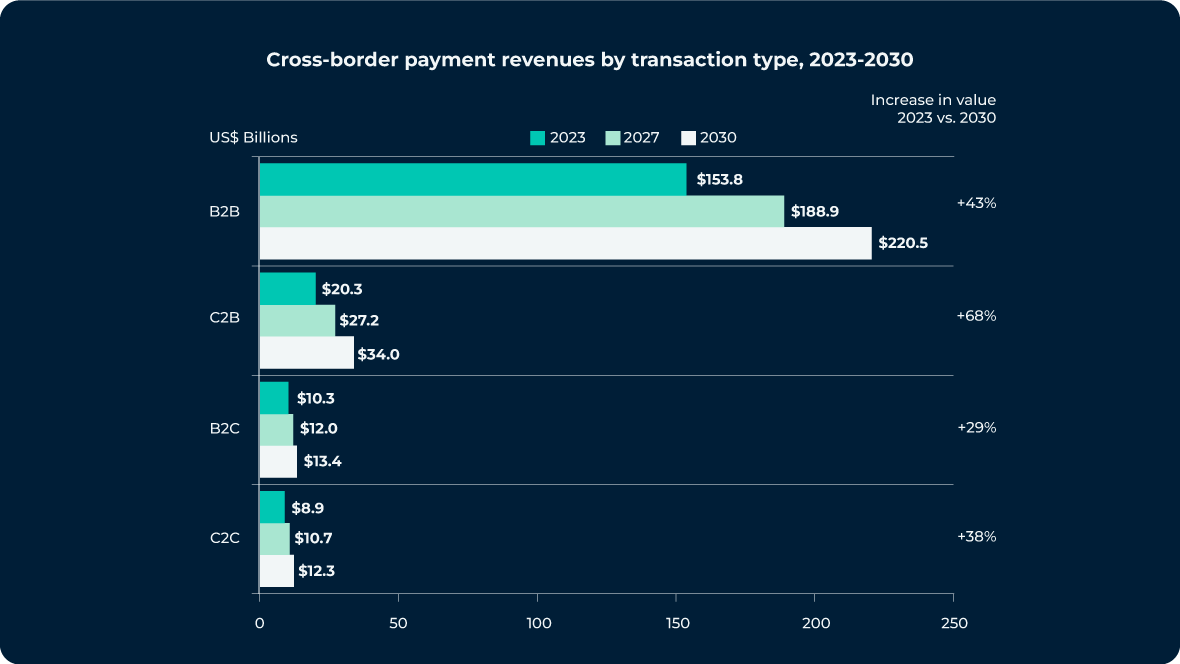
APAC to become the largest cross border payments market by 2030
Growth in cross border payments will vary by region, however prospects are brightest for payment corridors in Asia-Pacific which is forecast to grow by 60% by 2030. The expected boom in cross border payments across Asia Pacific reflects rapid economic growth occurring in the region, advances in infrastructure and payments technologies. Increased collaboration between regional governments is also fueling this growth through initiatives like China’s efforts to internationalize its central bank digital currency.
Prospects for Latin America are also bright, as the region’s economies increasingly go digital and investments in fintech unlock opportunities such as Brazil’s real-time payments system, PIX.
Growth for cross border transactions is more modest for North America and Europe, being more mature markets, although these regions will still benefit from the presence of key players and government policies that facilitate competition and innovation.
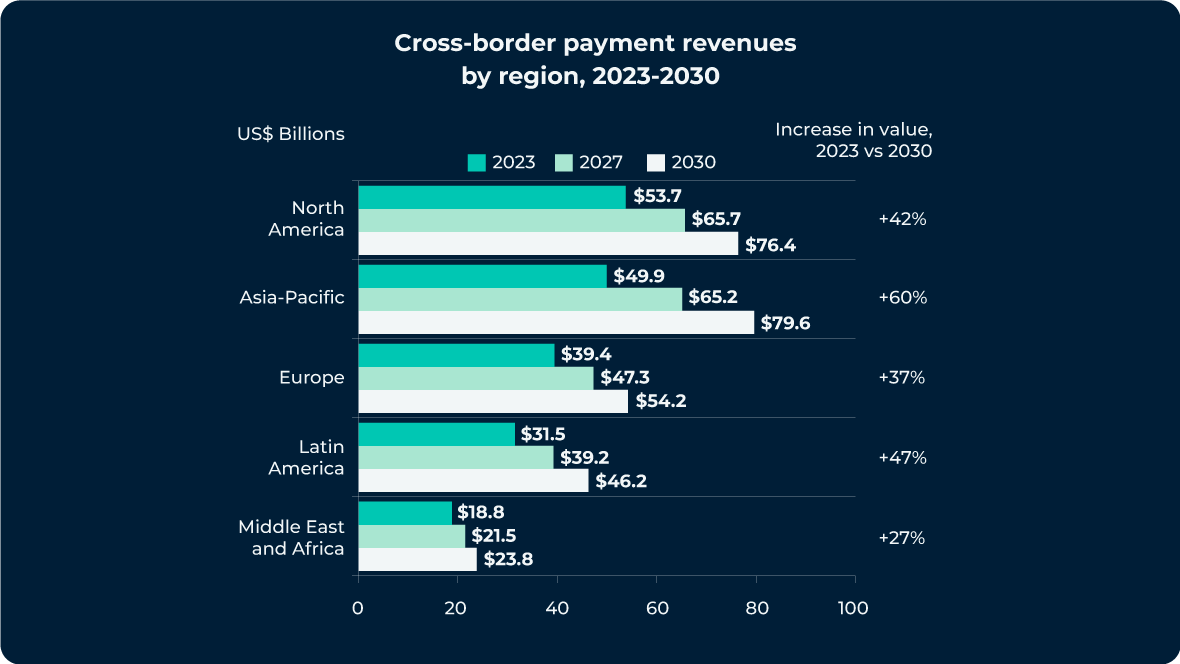
A new era for cross border payments
Cross border payments have entered a transformative era, poised to reach $290 trillion by 2030. This surge, driven by technological advancements, digital payment solutions, and evolving global trade dynamics, highlights immense opportunities for businesses and financial institutions alike. As the Asia-Pacific region emerges as a significant player, and Latin America accelerates its own digital transformation, companies must adapt and innovate to stay competitive in this rapidly evolving landscape.
Strategies and frameworks established by international bodies like the G20 and the Financial Stability Board (FSB) to enhance cross-border payments, emphasize collaborative efforts among jurisdictions and the private sector to tackle challenges and improve the effectiveness of cross-border payment systems. This requires global cooperation and innovative solutions to address challenges in cost, speed, access, and transparency. Embracing these changes will be crucial for capitalizing on the market’s growth and navigating the future of cross-border payments.
Want more insights on the topics shaping the future of cross-border payments? Tune in to Converge, with new episodes every Wednesday.
Plus, register for the Daily Market Update to get the latest currency news and FX analysis from our experts directly to your inbox.



